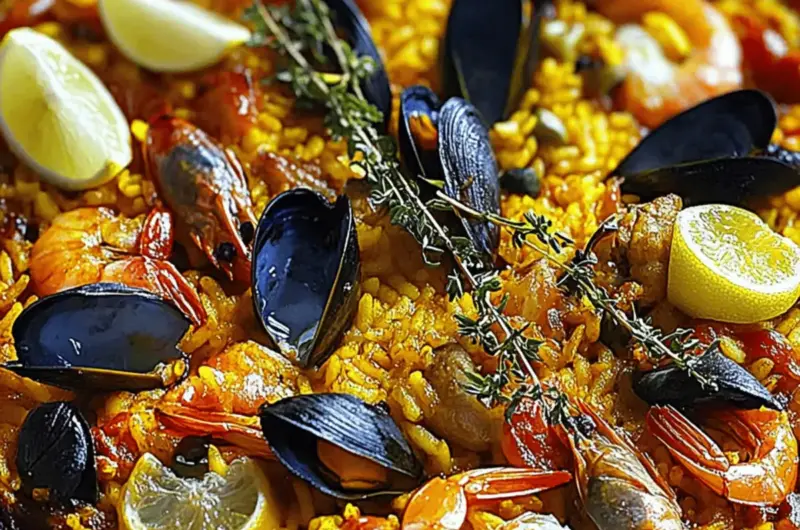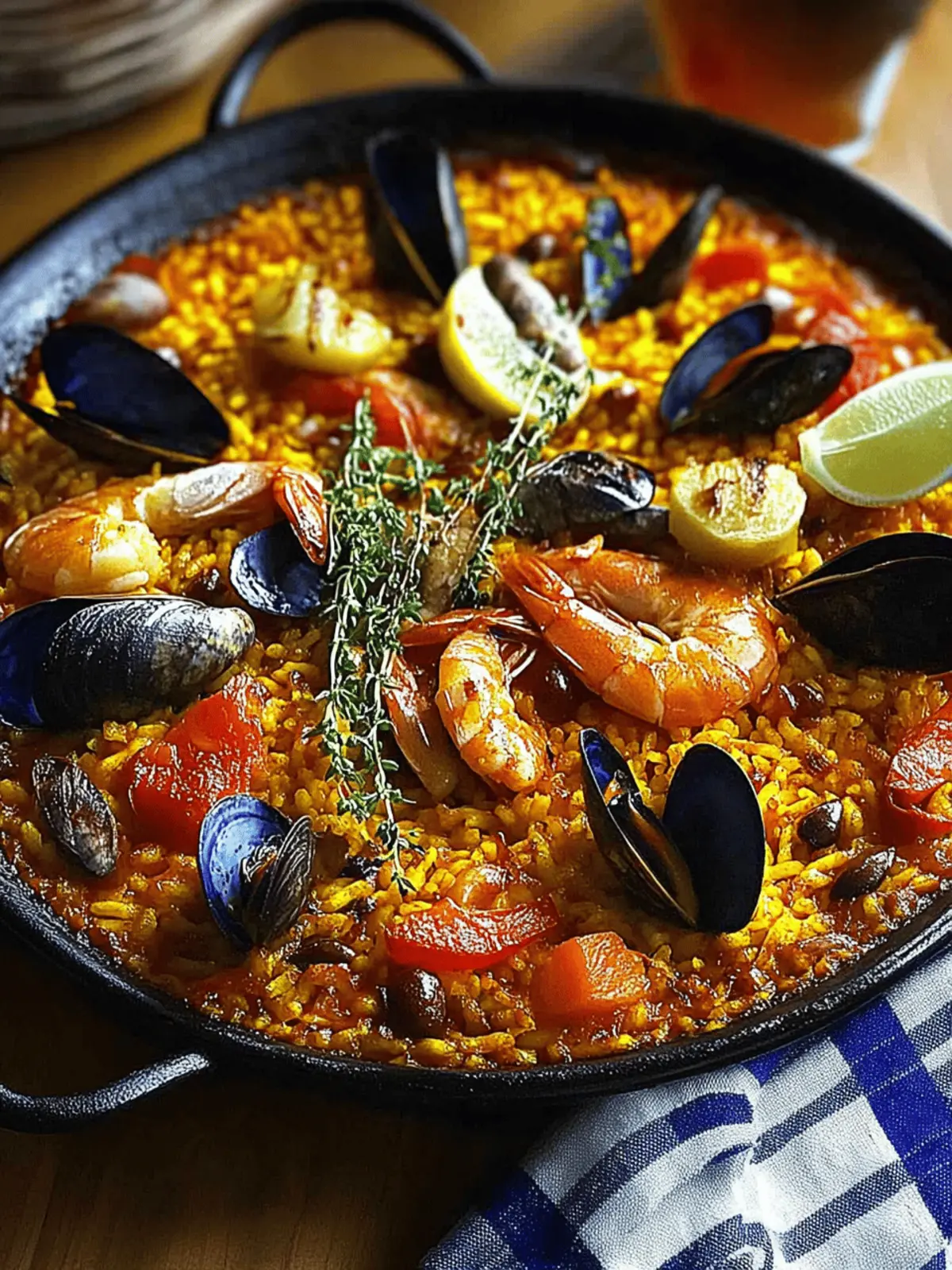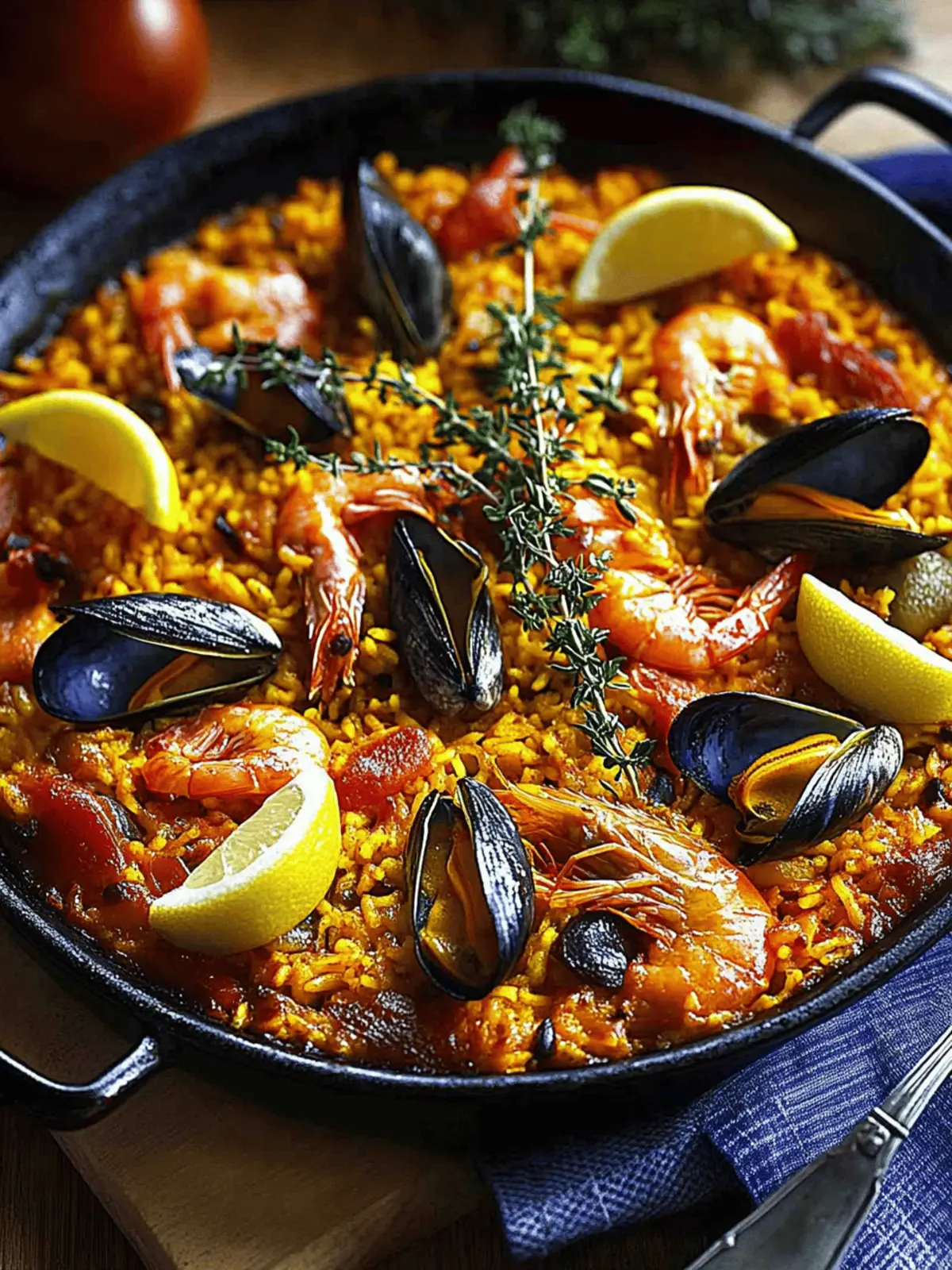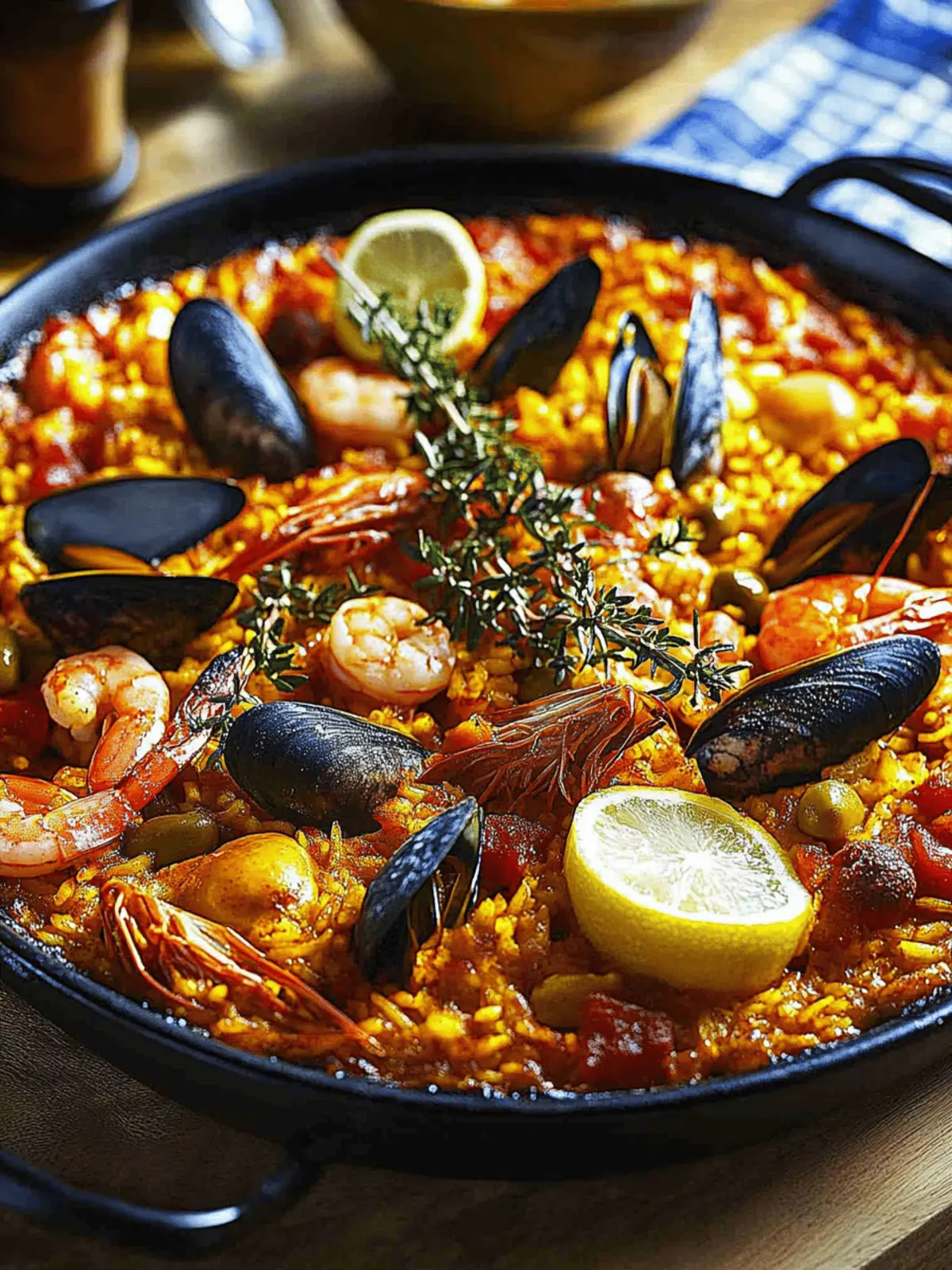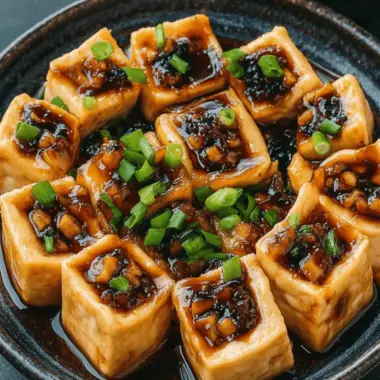There’s nothing quite like the sight of a colorful, steaming pan of Authentic Spanish Paella resting in the center of the table, inviting shared stories and laughter among friends and family. The moment the saffron-infused aroma fills the air, I’m instantly transported to the sunlit coast of Spain, feeling the warmth of the Mediterranean breeze. This one-pan wonder, packed with succulent seafood, tender chicken, and vibrant vegetables, is more than just a meal; it’s a celebration of flavors and cultures.
Whether you’re looking to impress dinner guests or wanting to indulge in a cozy night at home, this versatile dish can be tailored to suit your taste, making it a perfect choice for every occasion. Join me as I guide you through the steps to create this culinary adventure that not only delights the senses but also brings everyone together around the table!
Why is Spanish Paella a Must-Try Recipe?
Vibrant colors, aromatic spices—this dish is a feast for the eyes and palate! One-pan magic allows for easy clean-up, making it perfect for busy weeknights or gatherings. Endless customization means you can swap ingredients to fit your preferences, from seafood to vegetarian. Filling and satisfying, it’s a meal that brings everyone together. Plus, the sensational socarrat at the bottom? Pure bliss! If you’re seeking inspiration for variations, don’t miss my tips for creating a unique twist on this classic dish.
Spanish Paella Ingredients
For the Base
- Large Onion – Foundation flavor; sautéed for sweetness.
- Garlic (2 cloves) – Adds aromatic depth; can substitute with garlic powder.
- Red Bell Pepper – Adds sweetness and color; can use green pepper for a more bitter taste.
- Ripe Tomato or Crushed Tomatoes (1/2 cup) – Provides acidity and moisture; fresh tomatoes preferred.
- Olive Oil (1/4 cup) – For sautéing and flavor richness; use canola oil for a milder taste.
- Smoked Paprika (1 tsp) – Essential for authentic Spanish flavor; substitute with regular paprika for less smokiness.
- Saffron Threads (pinch) – Provides unique flavor and color; replace with turmeric for a less expensive option.
For the Protein
- Bone-in, Skin-on Chicken Thighs (1.5 lbs) – Adds richness and drama; replace with rabbit for authenticity.
- Spanish Chorizo (1 lb, sliced) – Introduces spiciness and depth; use Italian sausage as an alternative.
- Shrimp (1 lb, peeled and deveined) – Adds seafood flavor; any white fish can be substituted.
- Mussels (1 lb, scrubbed and debearded) – Enhances the seafood profile; use clams if preferred.
For the Rice & Liquid
- Bomba Rice (1 cup) – Traditional paella rice, absorbs flavors; Arborio rice is a substitute.
- Chicken Broth (6 cups, heated) – Acts as the cooking liquid; vegetable broth can be used for a vegetarian option.
- Dry White Wine (1/2 cup) – Adds acidity and flavor; replace with extra broth for a non-alcoholic version.
For Garnish & Additional Flavor
- Fresh Parsley (1/4 cup, chopped) – For garnish and freshness; omit if not available.
- Lemon Wedges – For serving; enhances flavors and presentation.
- Frozen Peas (1/2 cup) – Added for sweetness; can be omitted for a simpler version.
- Artichoke Hearts (1/2 cup, quartered) – Offers a unique texture; substitute with green beans.
- Fresh Rosemary – For aroma and garnish; thyme is a good alternative.
With these ingredients at your fingertips, you’re well on your way to making a mouthwatering Spanish Paella that everyone will cherish!
How to Make Spanish Paella
-
Prepare the Sofrito: Start by sautéing the large onion in olive oil over medium heat until it becomes translucent and fragrant. Add minced garlic and diced red bell pepper, stirring for another 3-4 minutes. Next, mix in the grated ripe tomato, smoked paprika, and saffron. Cook until the mixture thickens and reduces.
-
Sear the Chicken and Chorizo: In the same pan, brown the bone-in, skin-on chicken thighs skin-side down for about 5 minutes. Once nicely browned, add the sliced Spanish chorizo and cook until it releases its flavorful oils, about 3 minutes. Remove everything from the pan and set aside.
-
Build the Paella: Return the sofrito to the pan, adding the Bomba rice. Toast the rice for 2-3 minutes, stirring gently, and then deglaze with dry white wine, scraping up any bits stuck to the bottom. Pour in the heated chicken broth and return the chicken and chorizo to the pan as well.
-
Simmer: Bring to a gentle simmer, then lower the heat and allow it to cook uncovered for 15 minutes without stirring. This helps develop the socarrat, that delightful crispy bottom layer! Once time is up, arrange the shrimp and mussels on top. Cook until the shrimp turns opaque and mussels open, about another 5 minutes.
-
Add Optional Ingredients: If desired, gently stir in frozen peas and artichoke hearts, allowing them to cook for an additional 5 minutes to warm through.
-
Rest and Serve: Turn off the heat and cover the pan, letting it rest for 5-10 minutes. To serve, garnish with freshly chopped parsley and lemon wedges, and enjoy this vibrant dish straight from the pan!
Optional: Serve with crusty bread to soak up all the delicious juices.
Exact quantities are listed in the recipe card below.
Make Ahead Options
Preparing your Spanish Paella in advance is a great way to simplify meal prep, especially on busy weeknights! You can chop the vegetables (onion, bell pepper, and garlic) and store them in an airtight container in the refrigerator for up to 3 days. Additionally, you can marinate the chicken thighs and chorizo in spices and refrigerate them for up to 24 hours before cooking to enhance the flavors. When you’re ready to enjoy, simply sauté the prepped veggies, sear the marinated meat, and proceed with building your paella as instructed. This way, you’ll save time without sacrificing that rich, authentic taste that makes Spanish Paella such a beloved dish!
Expert Tips for Perfect Spanish Paella
-
Choose the Right Rice: Bomba rice is ideal since it absorbs flavors and maintains texture. Avoid using regular long-grain rice for best results.
-
Don’t Stir: Once you add the broth, resist the urge to stir! This allows the socarrat, a crispy bottom layer, to form—this is the hallmark of a great Spanish paella.
-
Use Fresh Seafood: For the most vibrant flavor, ensure your shrimp and mussels are fresh. Frozen options can work, but fresh truly elevates the dish.
-
Build Flavor with Sofrito: Take your time with the sofrito. Sauté the onions and peppers until fully softened to deepen the flavors throughout your Spanish paella.
-
Adjust Cooking Time: If you’re adding larger seafood, adjust cooking times for doneness. You want everything perfectly cooked, so keep an eye on the shrimp and mussels!
-
Serve Right from the Pan: For a rustic touch, serve your paella directly from the pan. This invites everyone to dig in and enjoy together, creating a communal dining experience.
What to Serve with Spanish Paella?
Paella is an incredible centerpiece for any meal, but pairing it with the right sides elevates the experience even further.
- Crusty Bread: Perfect for soaking up all that delicious broth, a loaf of fresh, crusty bread enhances that communal feel of sharing a meal.
- Simple Green Salad: A light, refreshing salad with mixed greens, cucumbers, and a lemon vinaigrette balances the richness of the paella beautifully.
- Garlic Aioli: This creamy dip adds a delightful garlic punch that pairs wonderfully with the seafood elements of the paella.
- Roasted Vegetables: A colorful medley of seasonal veggies brings a lovely sweetness and complements the savory flavors of the dish.
- Spanish Red Wine: A glass of fruity Tempranillo or Garnacha helps bring out the sophisticated flavors in the paella.
- Dessert Flan: End the meal on a sweet note with a smooth and creamy flan; its caramel notes harmonize beautifully with the meal’s bold flavors.
- Grilled Asparagus: The slight char and crispness of grilled asparagus adds a touch of elegance and an earthy note that enriches the experience.
These carefully chosen pairings will amplify your enjoyment of Spanish Paella, turning your meal into a celebration of flavors and fellowship!
How to Store and Freeze Spanish Paella
Fridge: Store leftover paella in an airtight container and refrigerate for up to 2 days. Reheat gently on the stove with a splash of broth to revive the flavors.
Freezer: If you’d like to keep leftover Spanish paella longer, transfer it to a freezer-safe container, ensuring it’s tightly sealed. It can be frozen for up to 3 months for best quality.
Reheating: When ready to enjoy your frozen paella, allow it to thaw in the fridge overnight, then reheat slowly on the stove, adding a bit more broth if necessary to keep it moist.
Room Temperature: Paella is best served fresh, but if left at room temperature, consume within 2 hours to ensure food safety.
Spanish Paella Variations & Substitutions
Feel free to play around with this paella recipe and make it truly yours with these delightful alternatives!
-
Vegetarian: Omit all meats and seafood, incorporating artichokes, asparagus, bell peppers, and zucchini instead for a garden-fresh twist. This version is vibrant and full of flavor!
-
Seafood Extravaganza: Boost the seafood quotient! Add scallops, calamari, or even lobster tails for a luxurious touch that seafood lovers will adore. This variation sets the stage for an ocean-inspired feast.
-
Spicy Kick: For those who crave heat, mix in diced fresh chili or a generous sprinkle of cayenne pepper while preparing the sofrito. This will warm things up beautifully and add depth to each bite.
-
Smoky Flavor: Enhance the smoky notes by adding a few drops of liquid smoke or increasing the amount of smoked paprika. This brings a delightful complexity that will transport you to Spain!
-
Artisanal Sausage: Swap Spanish chorizo for andouille or merguez sausage to introduce a different kind of spice and flavor profile. This twist infuses a hint of uniqueness into the classic base.
-
Coconut Rice: For a tropical flair, substitute half of the chicken broth with coconut milk, and use jasmine rice instead of Bomba rice. This will result in a creamy, aromatic paella that feels like a vacation on a plate!
-
Herb Infusion: Experiment with herbs! Add fresh basil or cilantro to the topping, or a sprinkle of fresh dill for a fragrant and fresh finish. This can change the game, introducing unexpected yet delightful sensations.
-
Lemon Zest: Don’t forget to add lemon zest to the broth for an invigorating brightness. This simple addition can elevate the dish and enrich each forkful with freshness!
Spanish Paella Recipe FAQs
What type of rice is best for Spanish Paella?
Bomba rice is the traditional choice for Spanish Paella, as it absorbs flavors beautifully while maintaining its structure. If Bomba rice isn’t available, Arborio rice is a suitable substitute, though it may become creamier due to its higher starch content.
How should I store leftover Spanish Paella?
Store leftover paella in an airtight container in the refrigerator for up to 2 days. When reheating, add a splash of broth to keep the rice moist and prevent it from drying out.
Can I freeze Spanish Paella?
Absolutely! To freeze Spanish Paella, transfer cooled leftovers into a freezer-safe container, ensuring it’s tightly sealed. It can be stored in the freezer for up to 3 months. When ready to enjoy, thaw in the refrigerator overnight before reheating on the stove.
What is the socarrat, and how can I achieve it?
The socarrat is the beloved crispy layer of rice at the bottom of the pan. To achieve it, avoid stirring the rice once you add the broth. Instead, let it simmer gently for about 15 minutes. For extra crunch, you can increase the heat slightly for the last few minutes of cooking, just be careful not to burn it!
What seafood works best in Spanish Paella?
Fresh seafood enhances the paella, so shrimp, mussels, and clams are excellent choices. Ensure they’re fresh for the best flavor. If you can’t find fresh seafood, you can use frozen options; just be sure to thaw them before adding to the dish.
Can I make a vegetarian version of Spanish Paella?
Very! For a delightful vegetarian variation, simply omit the meats and seafood, and load up on fresh vegetables like artichokes, asparagus, and bell peppers. You can also use vegetable broth in place of chicken broth to keep the flavors bright and vibrant!
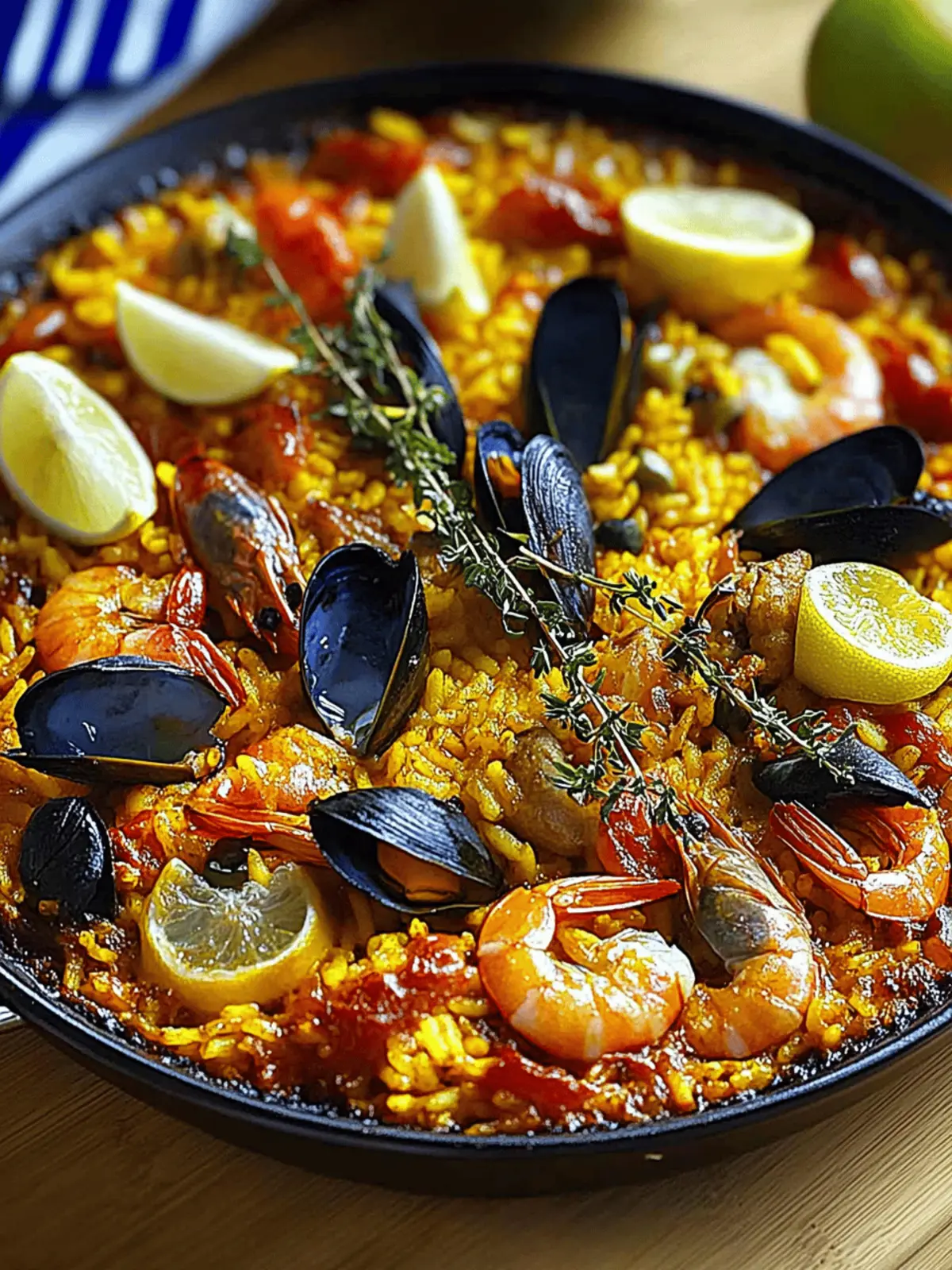
Savor Spanish Paella: Your Ultimate One-Pan Delight!
Ingredients
Equipment
Method
- Prepare the Sofrito by sautéing the large onion in olive oil until it becomes translucent. Add minced garlic and diced red bell pepper, cooking for another 3-4 minutes before mixing in the grated ripe tomato, smoked paprika, and saffron.
- Sear the Chicken and Chorizo by browning the bone-in, skin-on chicken thighs skin-side down for about 5 minutes. Add the sliced Spanish chorizo and cook until its oils are released, then remove everything from the pan.
- Build the Paella, returning the sofrito to the pan and adding the Bomba rice. Toast the rice for 2-3 minutes, deglazing with dry white wine. Pour in the heated broth and return the chicken and chorizo.
- Simmer by bringing to a gentle simmer and lowering the heat, cooking uncovered for 15 minutes without stirring. Arrange the shrimp and mussels on top and cook until shrimp turns opaque and mussels open.
- Add Optional Ingredients by gently stirring in frozen peas and artichoke hearts, cooking for an additional 5 minutes.
- Rest and Serve by turning off the heat, covering the pan to rest for 5-10 minutes before garnishing with parsley and lemon wedges.

